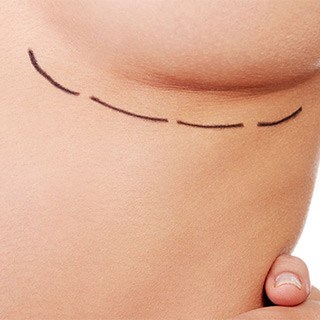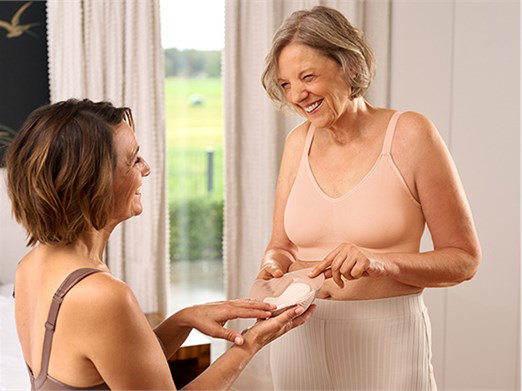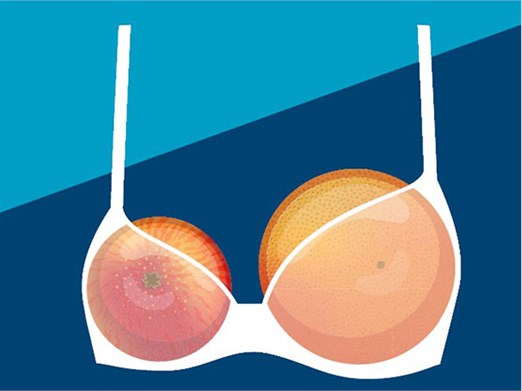Getting A Good Fit
 About six to eight weeks after breast surgery it will be time to see the post-mastectomy fitter. Women who have had a mastectomy should be able to wear a weighted breast prosthesis (breast form) at this time since their incision should be healed. Women who experienced breast conserving surgery will also benefit from a post-mastectomy fitting as there are partial breast prostheses to help fill in the missing portion of their breast and provide symmetry. Medicare and most private insurance plans have coverage for breast prostheses and bras. If you are in doubt about your coverage, call the number on your insurance card and inquire. Some policies have network provider restrictions to consider that can influence coverage benefits.
About six to eight weeks after breast surgery it will be time to see the post-mastectomy fitter. Women who have had a mastectomy should be able to wear a weighted breast prosthesis (breast form) at this time since their incision should be healed. Women who experienced breast conserving surgery will also benefit from a post-mastectomy fitting as there are partial breast prostheses to help fill in the missing portion of their breast and provide symmetry. Medicare and most private insurance plans have coverage for breast prostheses and bras. If you are in doubt about your coverage, call the number on your insurance card and inquire. Some policies have network provider restrictions to consider that can influence coverage benefits.
For women who have experienced breast surgery, a good fitter can be a lifesaver. Many women develop long term professional relationships with their fitters and consider them a member of their health care team.
A yearly visit to the fitter is a good idea. Women's bodies change in response to hormonal changes and weight fluctuations. The natural breast will change in response to these factors and a change in prosthesis may be needed to maintain symmetry. An initial fitting would be handled differently from fitting someone who has worn a prosthesis for years.
The art and science of a post-mastectomy fitting has many components. The fitter will first assess the patient to evaluate what is needed, then put their art form to work.
The key observation points a good fitter should include:
Your Bra
A good fitter will measure you when you come in to make sure you are wearing the right size mastectomy bra. The fit of the bra is extremely important in supporting the prosthesis and holding it snugly against the chest wall. Bras will last an average of 4 to 6 months before they need to be replaced. If the bra is too loose or stretched, the prosthesis will sag and feel much heavier. If the bra is too tight, the prosthesis will be visible and the band will be very uncomfortable.
Your Posture
If the fitter notices your shoulders are a bit uneven, she may suggest a different prosthesis for you. Some women need a weighted prosthesis to keep their chest wall muscles from contracting and pulling the shoulder out of symmetry. The fitter should be willing to work with your physician, if needed, to help keep you in perfect comfort and alignment.
Your Prosthesis
A good fitter will assess the symmetry of your current prosthesis when you come for a fitting. As women age, their breasts go through a process called involution, where the breast tissue becomes more fatty and less glandular. The breast takes on a more naturally draped appearance. The fitter can recommend a prosthesis that can recreate the density of varying types of breast tissue. Women who experience weight change will notice that their prosthesis no longer matches their natural breast. The fitter should make suggestions for other sizes and try other styles to create more symmetry. A good fitter will be knowledgeable about the latest breast prosthetic technology available and will keep her patients up to date.
The Fitting Process
The fitting should be conducted in a manner that offers the person being fitted complete privacy. The fitter should first assess the condition of the skin at the surgery site. There should be no drainage or open wounds.
The fitter should then determine the proper bra size by taking measurements at strategic points on the chest wall and around the rib cage. The fit of the bra is crucial to how well the prosthesis will be tolerated, and how natural the fit will be. Mastectomy bras today are pretty and feminine while providing the support needed to keep the prosthesis in the correct position. Although it is not mandatory to use a mastectomy bra with a breast prosthesis, it is recommended.
Next comes the prosthesis recommendation. The fitter will note the shape and drape of the existing breast and try a prosthesis that best approximates those dimensions. Prostheses come in many shapes, sizes, and colors to accommodate each woman's individuality. Some taper the material into the underarm area to fill in missing tissue there. Some prostheses are symmetrical, meaning they can be worn on either side, others are asymmetrical and are side specific. For women who have lost both breasts, the fitter will make suggestions for breast prostheses that are flattering to the patient's body dimensions.
The fitter will then place a soft drape or smock on the patient and show the patient in the mirror how she looks with the products chosen. It is recommended to take a close knit tee shirt so that you can evaluate this process yourself. This is where the woman should let the fitter know if she is happy with the results or if she wants to try something else. Most importantly, if she is not happy, she should speak up!
Before leaving the fitter's facility, instructions on use and care as well as the retailer's return policy should be given.
To find a certified mastectomy fitter near you, visit the Amoena Store Locator.







